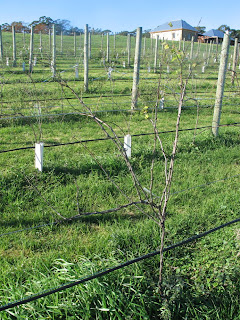One of the reasons for pruning is that grape bunches only grow on new shoots and it is necessary to get rid of most of the old growth from the previous season. But there is more to it than that. The vine has to be maintained in a workable shape that will facilitate vineyard management practices such as spraying and harvesting. Pruning also achieves a balance between vegetative and fruit growth which basically means there should be enough leaves to ripen the fruit produced in a canopy that provides an ultimate microclimate ie. not too much shade, not too much sunshine.
This is done by regulating the number of buds left on the mature one year old shoots (now called canes) during the pruning process and the spacing of those canes. The new shoots and their bunches, usually two, come from these buds.
There are three basic categories of pruning: hand, mechanical and minimal.
We will concentrate on the first one here.
The two most common forms of hand pruning are spur and cane.
We spur prune on cordons in our vineyard.

Cordon with Last Season's Canes
A cordon is a permanent vine arm either bi or unilaterally formed off the trunk during the original training process early in the vineyard’s development. On this arm, spaced about a hand’s span apart, are short permanent fruiting units that have been built up over the years by cutting back the canes that form on them, usually two.

Close up of Last Season's Canes
During the pruning process the highest cane of the two is completely removed and the lowest one reduced to two buds or a spur. All other extraneous canes shooting from the arms and trunk are also removed although in some cases the former are used to start new spurs when old ones are not positioned correctly, are too high on the cordon or have become damaged.

Highest Cane Removed
Spur pruning is easy, quick and economical and caters to the growth characteristics of most varieties except those whose basal buds exhibit low fruitfulness.

Lowest Cane Spurred to Two Buds

Completed Spur Pruned Vine
My friend’s vineyard just up the road is cane pruned.
This is a traditional pruning method of Old World vineyards.

Cane Trained Vine Before Pruning
The vines have no permanent cordons, only one (unilateral) or two (bilateral) one year old canes laid along the fruiting wire from the head of the vine which forms on top of the trunk. From these canes, new shoots with fruit emerge during the growing season.

Last Season's Fruiting Cane Removed
At pruning these now two year old canes and its canes are completely removed. A new cane formed from a two bud replacement spur left on the head during the previous year’s pruning is laid down on the wire and cut back to the required number of buds, usually 8-15, depending on the vigour of the vine. The lower cane on this spur is reduced to two buds ready to form a cane and another spur for the following year. All others canes that have formed around the head and trunk are removed.

Next Season's Fruiting Canes Laid
Down with Two Replacement Spurs
Sounds complicated and it can be. Certainly it takes much longer to prune grapevines in this way.
Again most varieties respond well to this form of pruning although those will strong apical dominance (where buds low on the cane tend not to shoot as well as those on the end) can cause problems. This can be overcome by arching the cane when laying it down or spraying with hydrogen cyanamide to promote even budburst.
All the cuttings are collected and piled up for burning later on in the year once they have dried out a little.
I am doing a few thousand cane pruned vines in the other vineyard as well as my own this year and expect to be finished sometime in August.
With climate change well and truly with us, bud burst for the early varieties could expected later that month.
For some updated pruning information (August 2014) click here.




















No comments:
Post a Comment